30 Best Flowers For Full Sun Ideas
Are you eager to know everything about the best flowers for the full sun? Here is an article just for you!
Most flowers need slight protection from harsh afternoon sun to prevent drying out and burnt foliage and petals. But, you can also grow sun-loving flowers in those hot and warm spots in your garden or patio.
In fact, the following sun-loving flowers thrive under direct sun and produce numerous blooms when exposed to full sun.
The colors scheme is spectacular, and the list is vivid and bright, perfect for the upcoming warm season!
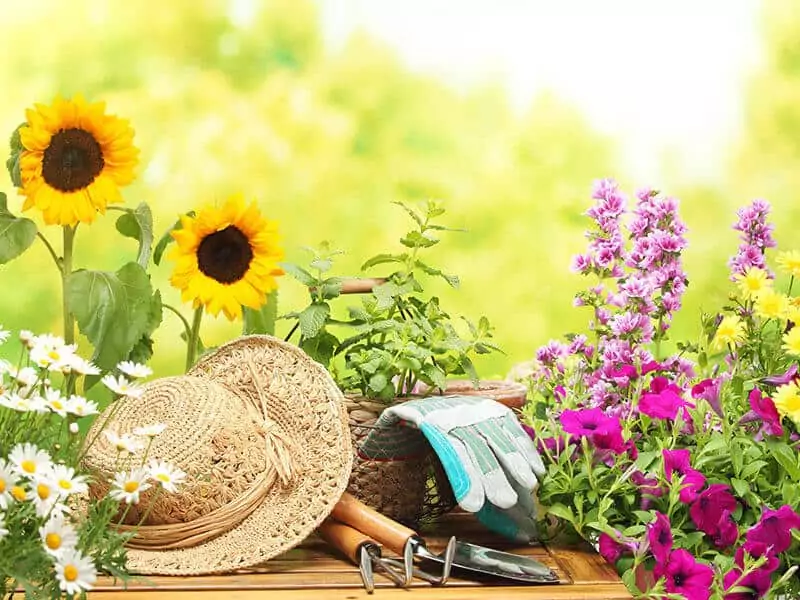
1. Plumbago
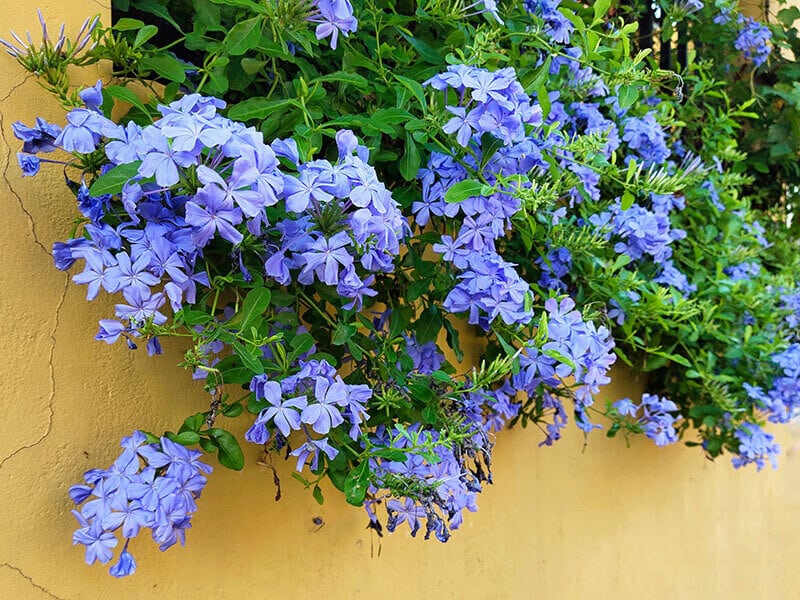
Plumbago auriculata, shortly Plumbago, is easy to mistake for the vine. But, it is actually a sprawling shrub, which can grow between six and ten feet.
The lovely doesn’t mind drought, heat, and full sun. Plumbago is easy to grow and develops bright blue blooms. In addition, Plumbago isn’t prone to pests and diseases, and it is also deer-resistant.
Plumbago looks best when planted in well-draining, fertile soil in full sun, but it can tolerate light shade.
You can see this video to know more:
2. Hibiscus
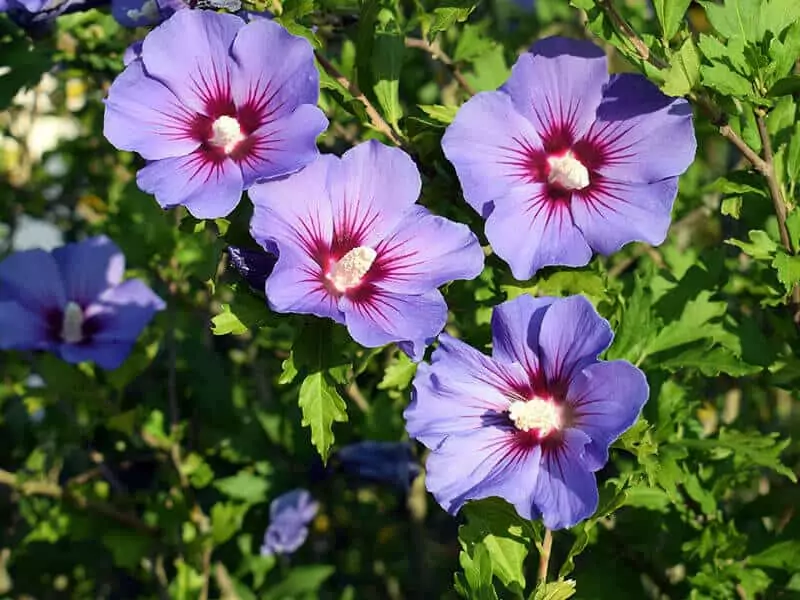
All Hibiscus varieties prefer full sun but may tolerate partial shade. You can choose between varieties with large and showy flowers, or ones with smaller blooms.
Hibiscus need fertile and fast-draining soil, preferably with a slightly acidic pH. The ideal location for the plant is full sun and protected from harsh winds.
Deadheading is recommended for Hibiscus because it encourages re-blooming. You should also use balanced fertilizer to boost growth and re-blooming.
3. Moss Rose
Portulaca grandiflora or Moss Rose is a hardy plant that requires simple care. The plant has specific foliage, which looks a lot like leaves on the typical succulent. Because of that, Moss Rose is drought-tolerant and perfect for hot and dry regions in Southern California.
You can plant it in flower beds or mixed containers with other plants. Portulaca is the perfect plant for full sun. The more sun the flower receives, the hardier it gets. Some species won’t even open their beautiful flowers on gloomy days.
4. Blanket Flower
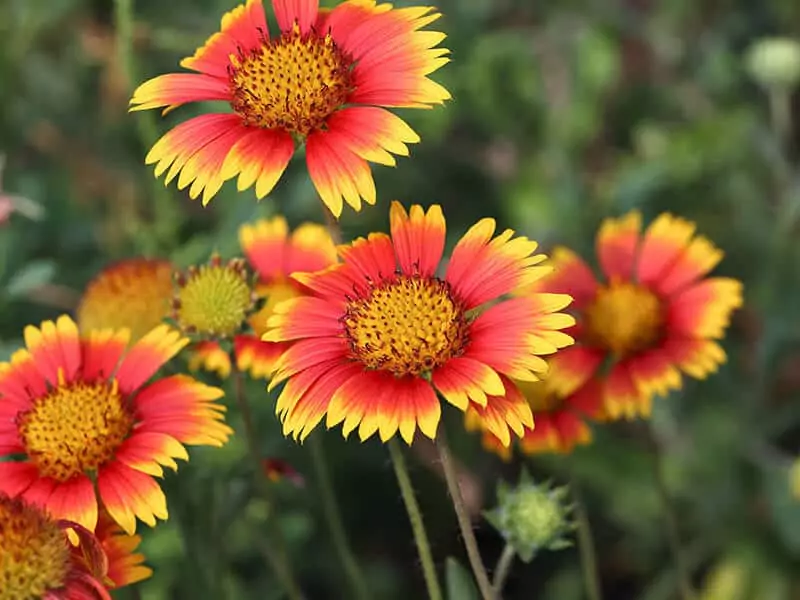
Gaillardia aka Blanket flower is a showy and vivid plant with huge and beautiful blooms which look like Daisies. Blanket flowers are great for sunny borders or pots for full sun areas on the patio or sideway.
The blanket flower grows well in low-nutrient soil. It will thrive even if you don’t use fertilizer, as long as the flower receives a lot of sunlight. In general, Gaillardia is a low-maintenance flower. It only needs occasional deadheading and cutting back in winter, so a fresh flower can come back in spring!
5. Powder Puff
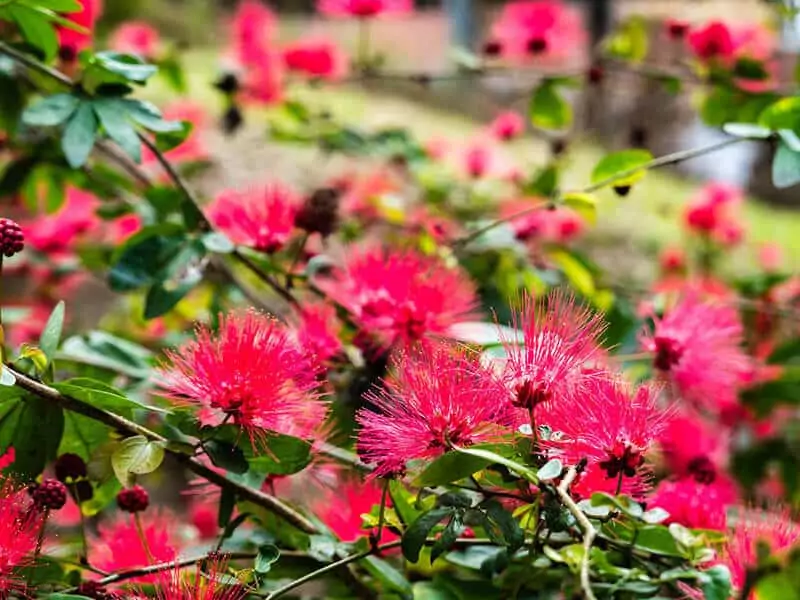
Calliandra is called Powder puff, because of the attractive foliage and unusual blooms. It grows between six and 13 feet in full sun or partial shade.
If you live in a northern climate, full sun is recommended, because Powder puff is a tropical plant that needs a lot of moisture and sun to thrive.
Calliandra needs well-draining soil and protection over the winter. It is a frost-sensitive plant, native to Brazil.
6. Verbena
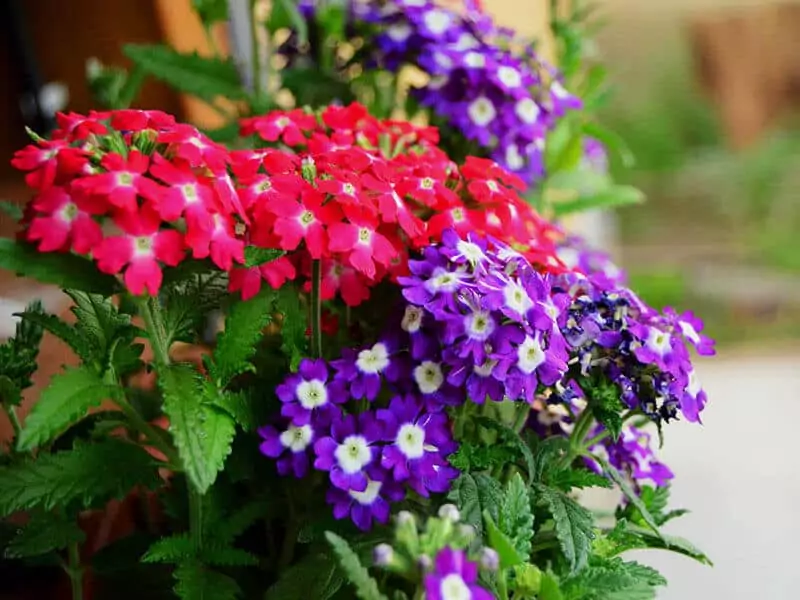
Verbena is native to South America, and it thrives in moist and well-draining soil. Pick a sunny and sheltered position if you want the best results. If you live in a cold region, you should take Verbena cuttings before winter to have a supply of new plants to grow when the warm season comes.
Replace the old Verbena plants with new ones in spring. Tall Verbena stems don’t need stalking or deadheading. Overall, Verbena isn’t prone to pests and diseases. However, keep an eye on the plant for powdery mildew to react in time!
7. King’s Mantle
Thunbergia erecta is a scientific name of the plant you will recognize as King’s Mantle. It is a beautiful evergreen perennial that prefers full sun locations. King’s Mantle develops wonderful fragrant flowers. They are usually purple or white and feature unique tubular shapes.
You can plant King’s Mantle any time of the year if you live in a warmer region. But, wait for spring to plant King’s Mantle in colder climates.
King’s Mantle is an easy-going outdoor plant. It needs a lot of moisture and grows pretty fast. King’s Mantle is considered aggressive in warm zones.
8. Bidens
Bidens flower can be found around the USA in all zones and all conditions. The flower grows on its own as long as it is in full sun and well-draining soil. Bidens look stunning in hanging baskets, containers, and window boxes.
The flower doesn’t need a lot of moisture. Moderate watering during warm weather is enough.
A great thing about Bidens is that it is available in many colors. So you can choose several varieties to create stunning colorful flowering beds. They will decorate your garden or patio or summer long and throughout autumn.
During the blooming season, Bidens attracts bees, hummingbirds, and pollinators.
9. Sunpatiens
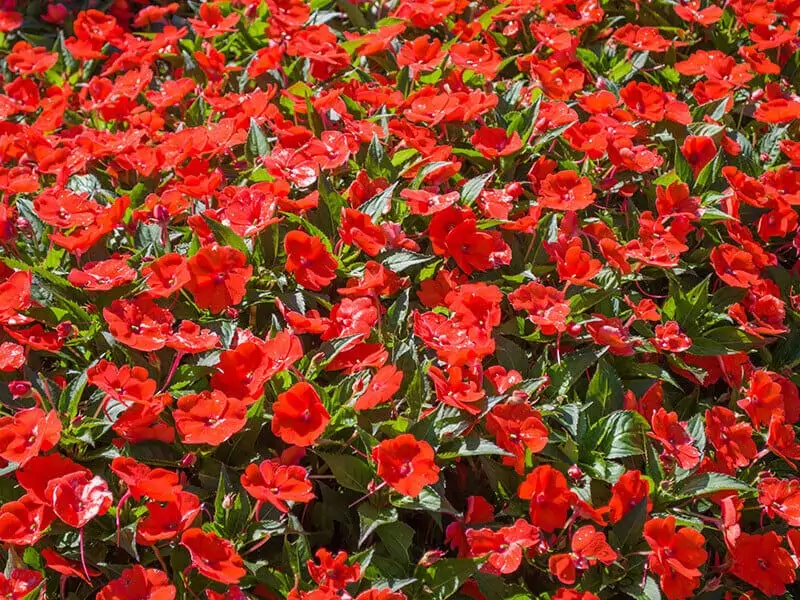
Sunpatiens or Touch me not is an excellent choice if you want to decorate your borders and containers in a sunny place for long months. The flowering season starts in May and often lasts until the end of October.
Sunpatiens have ordinary soil needs – medium moisture, well-draining, and not soggy. The flower will also appreciate humus-rich soil.
It thrives in full sun but may get used to partial sun. You can grow it as an outdoor annual or an indoor perennial.
Check out this video to know:
10. Sweet Alyssum
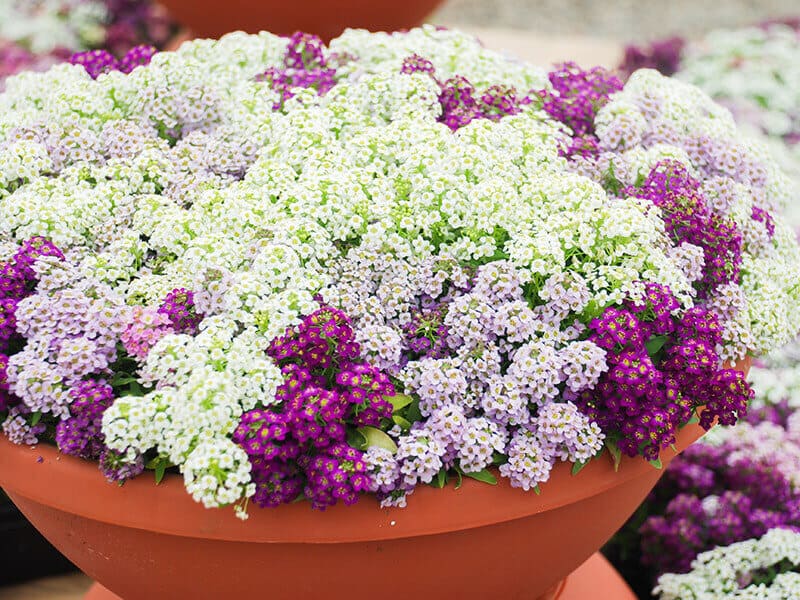
When you take care of Sweet Alyssum, scientifically known as Lobularia maritima, it is important to know a few things. First, Sweet Alyssum needs full sun exposure to survive. Next, the flower needs only an inch of water per week. It is best to let the soil dry between waterings to prevent root problems.
The last thing to keep in mind is to regularly deadhead spent blooms. Sweet Alyssum self-seeds, so it will continuously grow again. Dead-heading will help with the development and new blooms.
11. Sunflower
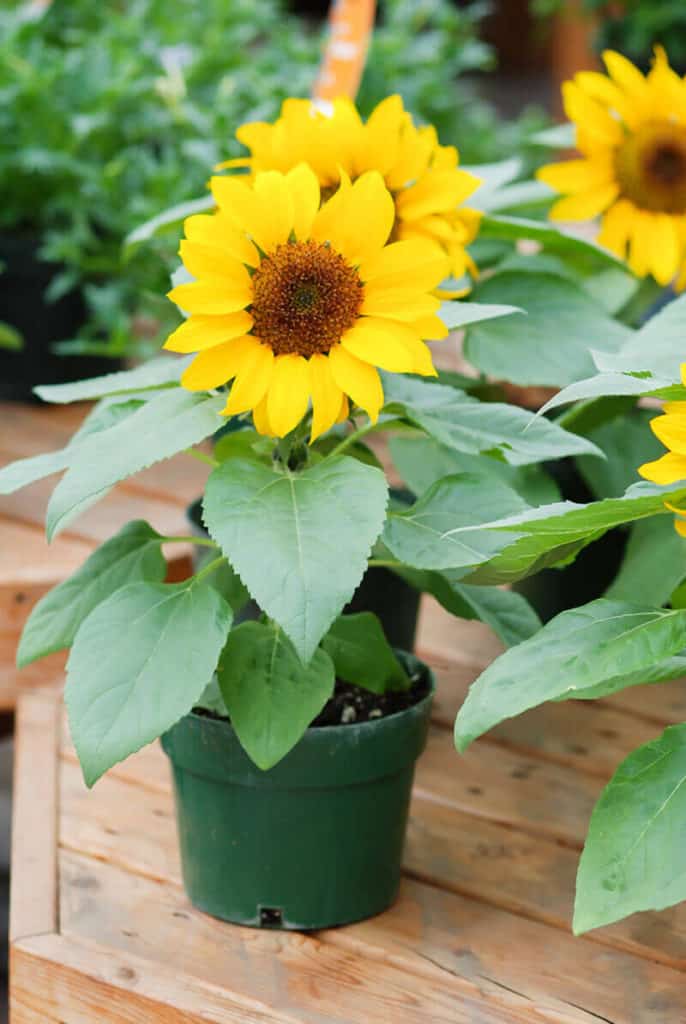
Here is a plant that loves the sun so much that it has sun in the name! I am talking about the Sunflower aka Helianthus annus. Sunflower is a beautiful flower, and it is easy to grow from seeds.
On average, Sunflowers grow up to six feet and produce stunning, long-lasting flowers. Sunflowers are great as cut flowers because they are attractive and stay fresh for a long time.
Other than full sun exposure, Sunflowers need well-draining and rich soil. A large amount of manure or well-rotted compost will help!
These amazing flowers need a lot of water and stalking if you choose taller varieties.
12. Globe Amaranth
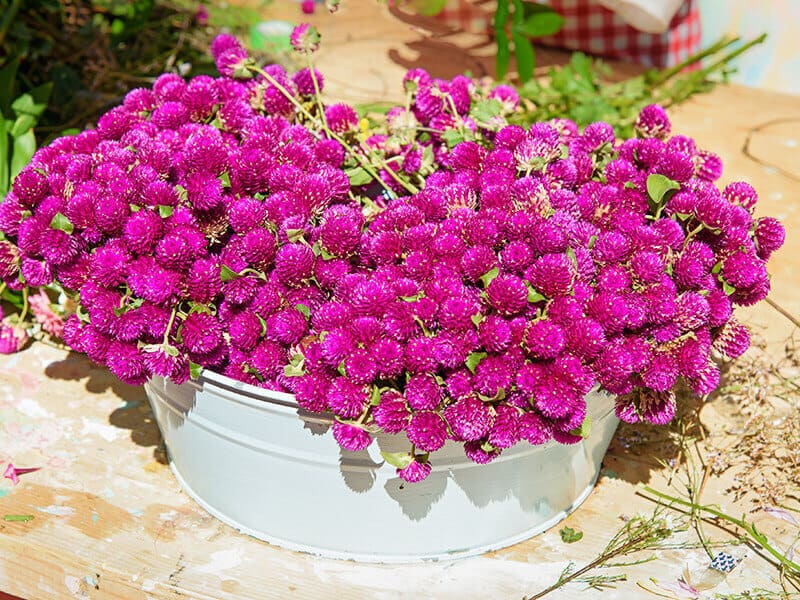
Globe Amaranth or Gomphrena is a simple way to spruce up your garden with unusual and colorful blooms. You can also grow Globe Amaranth in containers, but it is important to choose suitable varieties.
In general, shorter Globe Amaranth grows well in pots, but taller cultivars are only suitable for borders and garden soil. You can grow them next to Zinnias, Dahlias, and Salvias.
Globe Amaranth is a perennial in warm zones nine and ten. In colder zones, people grow it as an annual garden plant.
Juvenile Globe Amaranth is drought-sensitive, while adult plants don’t need as much water.
13. Bleeding Heart Vine
Bleeding Heart vine is an attractive bushy climber, which looks especially charming in pots. The scientific name is Clerodendrum thomsoniae.
Beautiful Bleeding Heart vine may survive in partial sun, but it needs full sun to bloom. It is a tropical plant that can grow as perennials in warm zone nine. In the cold zones, the Bleeding Heart vine needs protection from frost.
When the temperatures drop between 45 degrees Fahrenheit, you should move your Bleeding Heart indoors.
14. Brazilian Jasmine
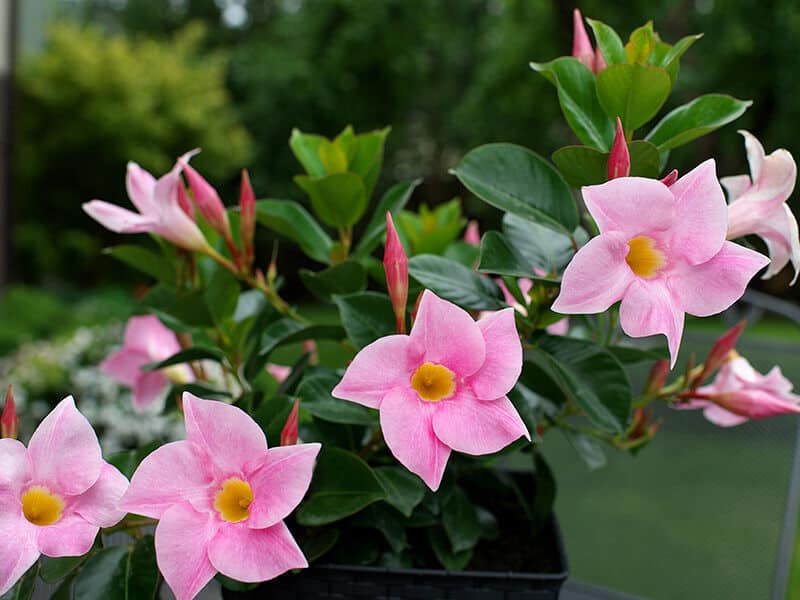
Mandevilla sanderi or Brazilian Jasmine is most beautiful from mid-summer to late fall. The flowers are bright pink, red, white, and yellow and stand out beautifully against the green grass.
In warmer climates, the plant is perennial, because it dies with the first frost. When you grow Mandevilla sanderi in warm weather and full sun, it can grow up to 20 feet in height. In less perfect conditions, the average height is five feet.
You can also grow Brazilian Jasmine in a container outside in the full sun. Then, bring the flower indoors during the winter until the warm season comes. Don’t expect the plant to bloom indoors, but it will survive in frosts and cold weather.
15. Bottlebrush
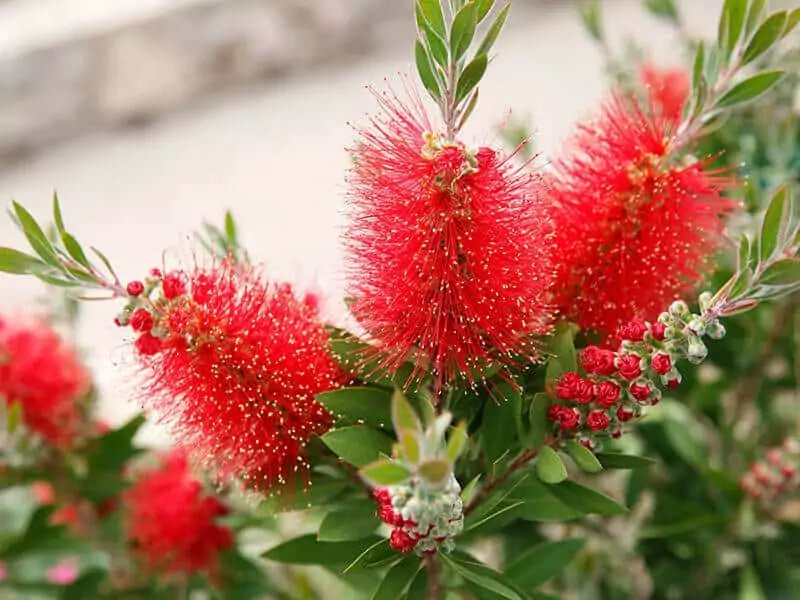
A Bottlebrush or Callistemon produces charming spikes of flowers on the end of the tall and sleek stems. Most Bottlebrush varieties have reddish flowers, but you can also find varieties with yellow flowers.
The ideal climate for Bottlebrush is mild, so it grows best in zones from 8b to 11. In colder zones, Bottlebrush can be grown in containers.
If you don’t want your Bottlebrush to grow vigorously as a large and bushy shrub, prune it every year. Rich soil with sand is an idea, and the well-drainage is a must.
16. Marigold
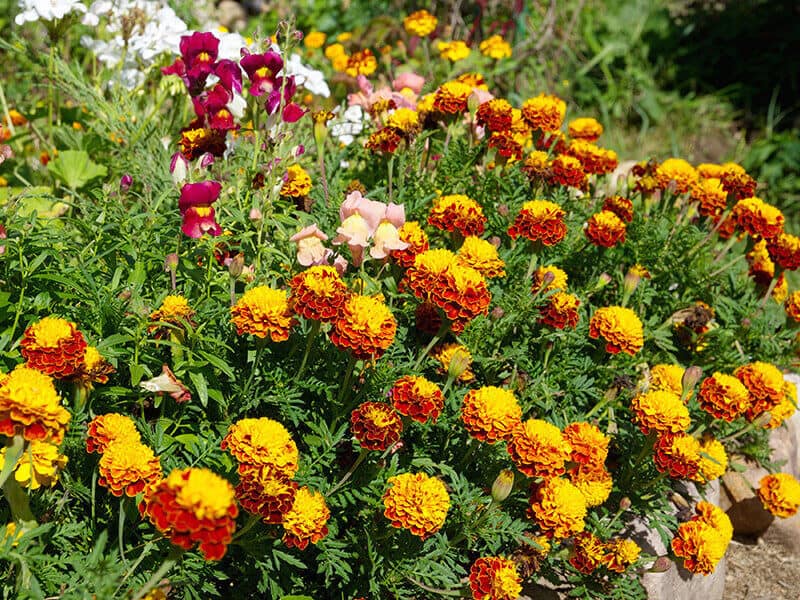
Cheerful Marigolds are perfect flowers for full sun locations in your garden. Provided with full sun, Marigolds bloom all summer and don’t require complex maintenance, except for occasional deadheading.
Most Marigold varieties grow best when you plant them in spring after the first frost has passed. Growing them is simple, and you can sow seeds directly in the warm soil on a spring day! In warm weather, Marigolds sprout in a week or two. Wait for an additional two months for blooms to appear!
17. Angelonia
Angelonia angustifolia, shortly Angelonia, features charming blooms which look like snapdragons.
Angelonia blooms from late spring to late fall and grows best in heat and dry conditions.
Angelonia is a self-sowing and self-cleaning plant. So, it is one of the best low-maintenance flowers for full sun. It will basically thrive in neglect. Pick slightly acidic soil for Angelonia to ensure it has enough nutrients to thrive.
After planting, Angelonia needs moderate moisture. As it matures, the plant becomes more drought-resistant.
18. Geranium
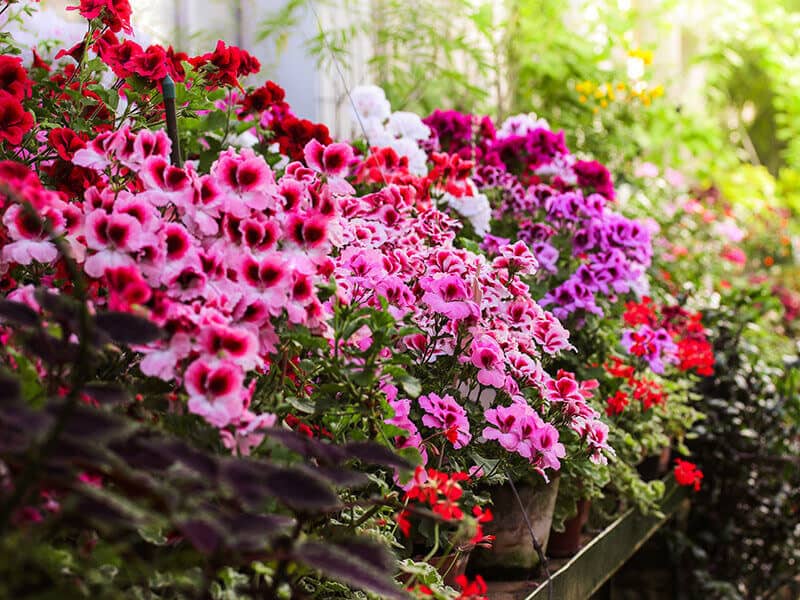
Pelargonium aka Geranium features vibrant and fragrant flowers which look attractive in full sun gardens, mixed and single containers.
Geranium needs free-draining soil and a little care to thrive. It doesn’t need a lot of water, only a moderate amount in spring and summer is enough.
Also, Geranium isn’t a heavy feeder. You can use a balanced, liquid fertilizer once or twice a month during spring. When the flowers form, stop the fertilization and enjoy the lovely blooms!
19. Pentas
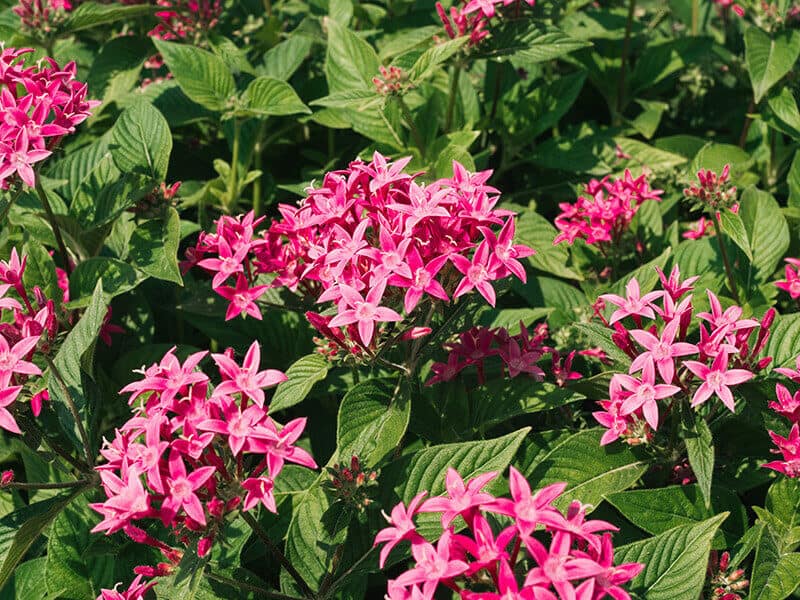
Pentas lanceolata thrives when you plant it in late spring. Choose a spot that gets more than six hours of sunlight per day and has fast-draining soil. Pentas grow around two feet tall and 15 inches wide.
Therefore, when you plant Pentas, leave enough space for each sprout to develop.
If you prefer container gardens, you can plant them more closely. Pentas need regular watering after planting, especially during dry spells. Also, I recommend using balanced fertilized once a month to boost the growth and induce blooming.
Check out this video to know:
20. Lantana
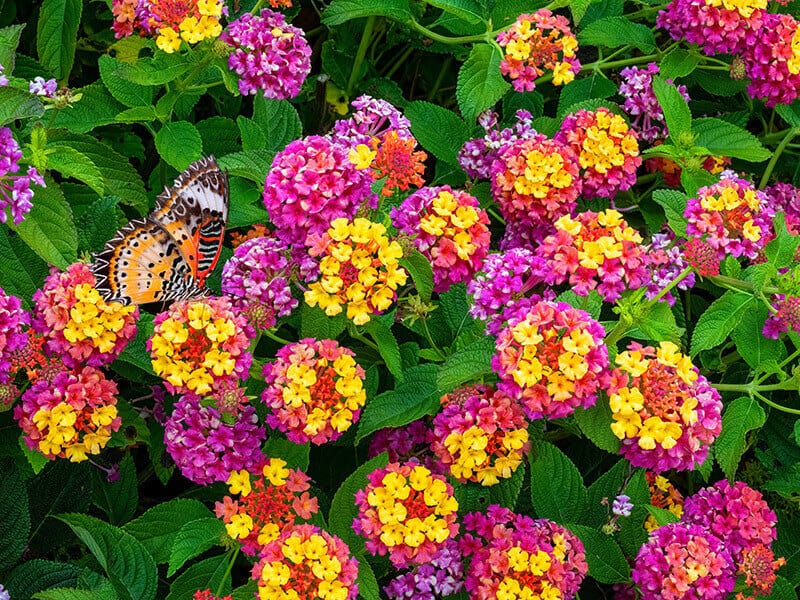
Lantana camara is an easy way to transform any landscape and provide it with rich colors and a tropical vibe! Lantana grows best in neutral soil, with a pH from 6.0 to 8.0. It needs well-draining soil to maintain healthy roots and full sun to grow vigorously.
Lantana requires only about an inch of water every week. You should never let the plant dry because it will prevent the plant from blooming.
Also, Lantana is a little frost-hardy. It can survive through light and occasional frosts. But prolonged and extreme temperatures will kill the plant.
Remember to prune Lantana regularly if you want to keep it bushy and healthy.
21. Canna
Colorful Canna indica blooms appear on tall stems from late spring to the first frost. Cannas thrive when other flowers dry and die – in full sun and extreme July and August heat.
Cannas also look great when planted in containers. You can pick various cultivars with yellow, red, pink, or orange flowers. Also, Cannas are praised for their beautiful foliage. Some cultivars also have variegated foliage, which makes them stunning even outside the blooming season.
22. False Heather
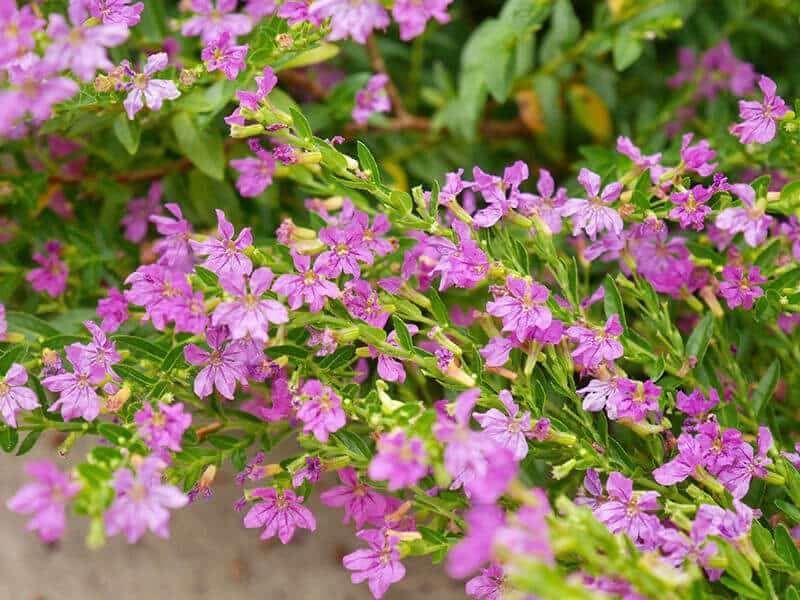
False Heather or Cuphea hyssopifolia is native to Mexico, Guatemala, and Honduras. Therefore, it is often called Mexican Heather!
It is a charming shrub, with bright blue or lavender flowers. Mexican Heather is easy to grow outdoors in most southern zones in the USA. But, if you live in colder zones, you should protect the plants from frost or grow them as annuals.
Overall, Mexican Heather isn’t a thirsty plant. But, young plants need constant watering to establish. Also, you can use organic fertilizer to promote bushier growth.
23. Silver Cock’s Comb
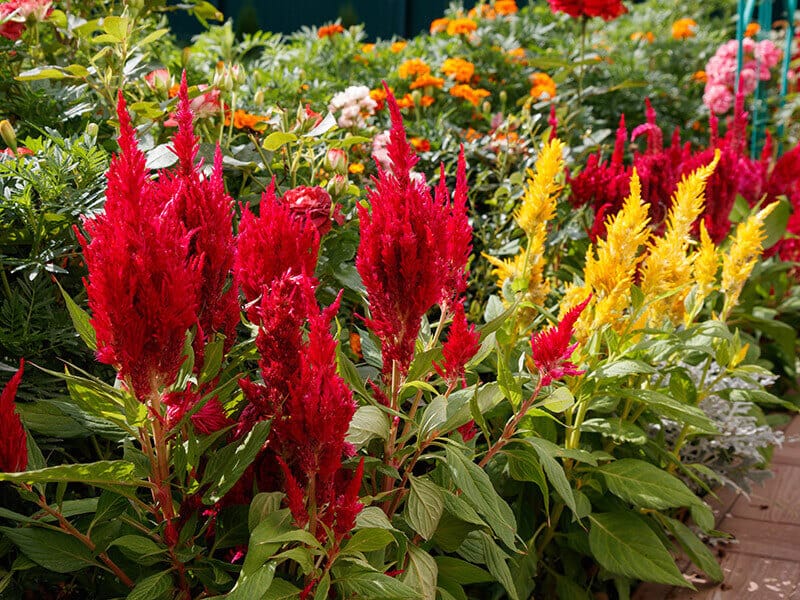
Celosia argentea or Silver Cock’s Comb isn’t picky about the soil. It grows best in neutral to acidic, fast-draining, and evenly moist soil. Silver Cock’s Comb produces bright wonderful red, yellow, pink, white, and orange flowers.
The flower needs warm weather and grows best in zones from nine to 12. Silver Cock’s Comb is a low-maintenance flower. It only requires occasional watering during dry spells and dead-heading to encourage new growth.
In addition, Silver Cock’s Comb rarely suffers from pests and diseases. But, soggy soil might increase the risk of fungal diseases. The fool-proof watering schedule for Silver Cock’s Comb is to water the plant when the top inch or two feel dry to touch and not sooner!
24. Petunias
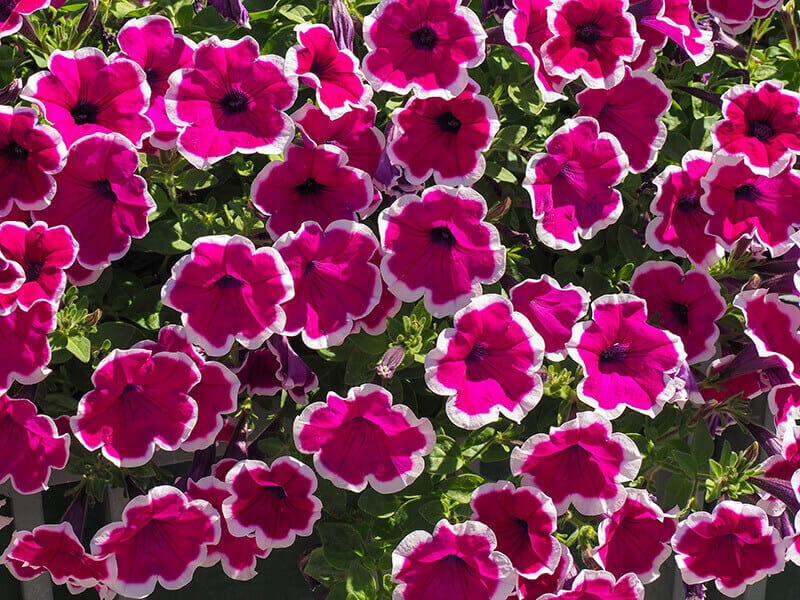
Petunias are versatile flowers, perfect for full sun. You can grow Petunias as a single-specimen plant or in mixed-containers and garden beds, with other sun-loving plants. There are many varieties of Petunia, and some grow better in the garden while others are cultivated for pots.
Petunias produce the most wonderful, showy flowers when exposed to more than six hours of sunlight. In the shade, your Petunias can survive, but they won’t bloom. Other growing requirements include moderate watering and fertilization.
25. Texas Bluebonnets
Lupinus texensis or Texas Bluebonnets is an outstanding wildflower, which spreads around Texas like a wonderful blue carpet every spring. But, there are a few things to know to help your Texas Bluebonnets establish well.
Sow seeds in early October to ensure there is enough warmth for germination. Rocky, alkaline soil, and full sun are the best for Texas Bluebonnets.
Texas Bluebonnets grow in patches and will bloom in late March or early April.
26. Ground Orchids
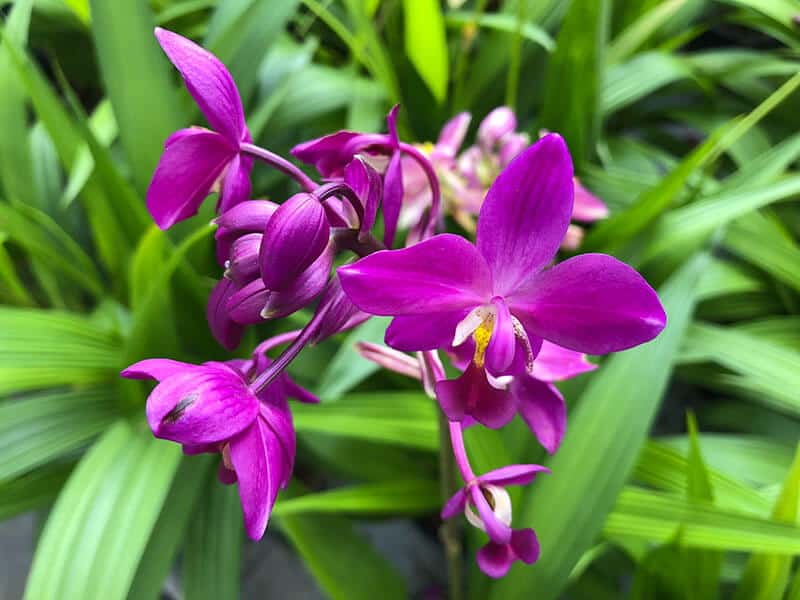
Spathoglottis plicata is a flower better known as Ground Orchid. It is a common flower in India, Indonesia, and Australia. Lately, Ground Orchid has become popular in Florida and Texas.
In warm zones, Ground Orchids grow well year-round in gardens. In colder zones, you should grow Ground in containers, which you can bring indoors during winter.
Pick peat-based and well-draining soil for your flowers. Water moderately, and be careful never to allow the plants to sit in water.
After planting and during the growing season, Ground Orchids need more water. Also, keep in mind that these plants are heavy feeders and they need a lot of plant food.
Pick nitrogen-rich fertilizer to induce more blooms!
You can see this video to know more:
27. Diamond Frost Euphorbia
Diamond Frost Euphorbia is an excellent choice for adding a dramatic effect in single containers. Also, because the blooms are white, they are easy to mix with other flowers in mixed containers and garden beds.
Euphorbia Diamond Frost is a reliable flowering plant and blooms for a long-time until the first frost. Additionally, Euphorbia doesn’t need dead-heading. It is also a relatively drought-tolerant plant, even in warm seasons.
28. Scaevola
Scaevola aemula, shortly Scaevola is an annual flower in zones colder than 9a to 11. It is a brilliant choice for your garden, because of the several features.
First, Scaevola is drought-tolerant once it is established. It features self-cleaning habits, and the plant isn’t prone to pests or diseases. Additionally, it attracts pollinating insects, butterflies, bees, and hummingbirds!
Scaevola tolerates all soil types, except for soggy soil. It grows best when you plant it in the spring, after the last frosts.
Ultimately, Scaevola is praised for its lovely pink, blue, purple flowers with bright throats!
29. Bolivian Begonia
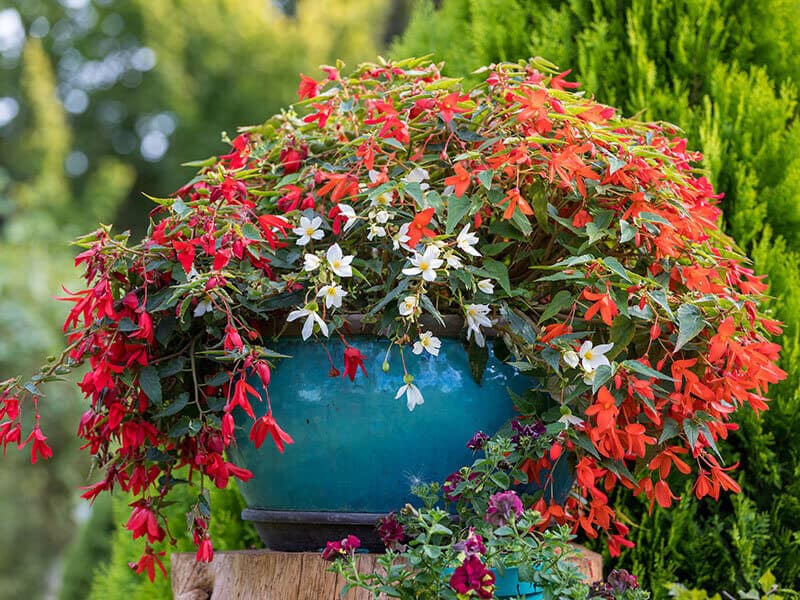
With its flared and hanging flowers, Begonia boliviensis is one of the most attractive flowers for full sun. It looks especially decorative in hanging pots!
Bolivian Begonia is great for full sun, but it can tolerate partial shade. There is a slight difference in light preferences among cultivars. Consider Bolivian Begonia with bronze foliage for full sun.
Some varieties can also grow in the full shade but expect fewer flowers and a less luscious appearance.
30. Million Bells
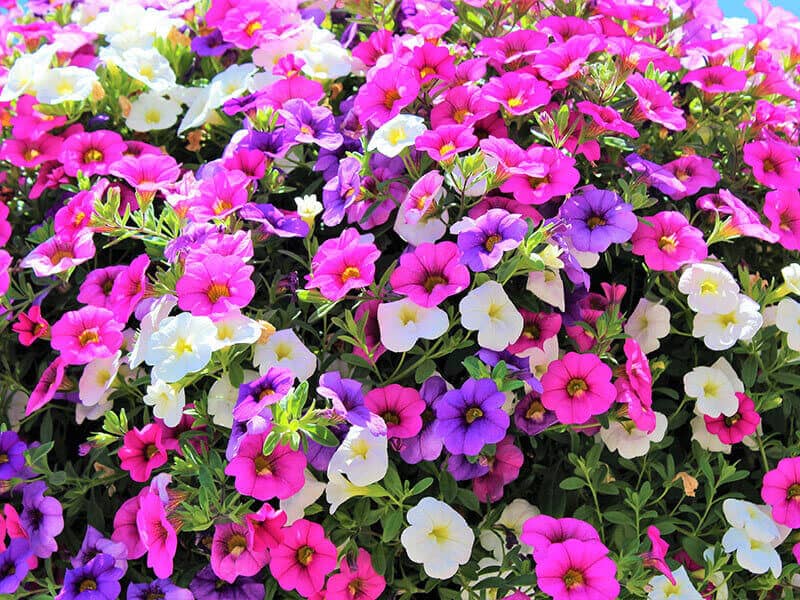
Calibrachoa or Million Bells flower look like mini Petunia with its masses of bright blooms! Calibrachoa is an excellent container plant but looks great in the garden when planted with Verbena, Nemesia, and Salivas.
You cannot grow Million Bells from seeds. Instead, look in for transplant plants in the local nursery in late spring.
After planting, Calibrachoa needs consistent moisture. If the leaves become yellow, use a balanced fertilizer to feed the plant. Add more water if you notice wilting leaves, and don’t worry about sticky residue on the foliage. It is a common feature of all Million Bell varieties.
Flowers Add Life To Sunny Locations
Have you picked your favorite flowers for full sun yet? I understand, picking only one flower for full sun can be difficult! That is why I choose Canna and Hibiscus for sunny spots on my patio!
In most cases, these sun-loving flowers are hardy enough to withstand direct sunlight, drought, and pests. It makes them ideal low-maintenance ornamental plants.
What are your thoughts on my list? Would you add something?

